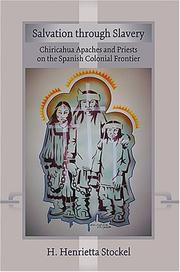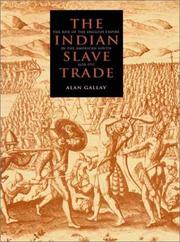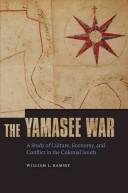| Listing 1 - 10 of 10 |
Sort by
|
Book
ISBN: 164336362X Year: 2022 Publisher: Columbia, South Carolina : The University of South Carolina Press,
Abstract | Keywords | Export | Availability | Bookmark
 Loading...
Loading...Choose an application
- Reference Manager
- EndNote
- RefWorks (Direct export to RefWorks)
"An examination of the dual Scottish-Yamasee colonization of Port Royal. Those interested in the early colonial history of South Carolina and the southeastern borderlands will find much to discover in Carolina's Lost Colony in which historian Peter N. Moore examines the dual colonization of Port Royal at the end of the seventeenth century. From the east came Scottish Covenanters, who established the small outpost of Stuarts Town. Meanwhile, the Yamasee arrived from the south and west. These European and Indigenous colonizers made common cause as they sought to rival the English settlement of Charles Town to the north and the Spanish settlement of St. Augustine to the south. Also present were smaller Indigenous communities that had long populated the Atlantic sea islands. It is a global story whose particulars played out along a small piece of the Carolina coast. Religious idealism and commercial realities came to a head as the Scottish settlers made informal alliances with the Yamasee and helped to reinvigorate the Indian slave trade--setting in motion a series of events that transformed the region into a powder keg of colonial ambitions, unleashing a chain of hostilities, realignments, displacement, and destruction that forever altered the region"--
Enslaved Indians. --- South Carolina --- South Carolina --- History --- History
Book
ISBN: 0674056876 9780674056879 Year: 2012 Publisher: Cambridge, Massachusetts : Harvard University Press,
Abstract | Keywords | Export | Availability | Bookmark
 Loading...
Loading...Choose an application
- Reference Manager
- EndNote
- RefWorks (Direct export to RefWorks)
Indian captivities --- Enslaved Indians --- Slavery --- Indians of North America --- History.

ISBN: 1283636905 0826343279 9780826343277 9780826343277 6613949361 9786613949363 9781283636902 9780826343253 0826343252 Year: 2008 Publisher: Albuquerque University of New Mexico Press
Abstract | Keywords | Export | Availability | Bookmark
 Loading...
Loading...Choose an application
- Reference Manager
- EndNote
- RefWorks (Direct export to RefWorks)
Stockel examines the brutal history of forced conversion and subjection of the Chiricahua Apaches by Spanish priests during the seventeenth and eighteenth centuries.
Chiricahua Indians --- Indians, Treatment of --- Enslaved Indians --- Christianity and culture --- Missions --- History. --- Jesuits --- Franciscans --- New Spain --- Mexico

ISBN: 1281731404 9786611731403 0300133219 9780300133219 9781281731401 0300087543 9780300087543 6611731407 Year: 2002 Publisher: New Haven : Yale University Press,
Abstract | Keywords | Export | Availability | Bookmark
 Loading...
Loading...Choose an application
- Reference Manager
- EndNote
- RefWorks (Direct export to RefWorks)
This absorbing book is the first ever to focus on the traffic in Indian slaves during the early years of the American South. The Indian slave trade was of central importance from the Carolina coast to the Mississippi Valley for nearly fifty years, linking southern lives and creating a whirlwind of violence and profit-making, argues Alan Gallay. He documents in vivid detail how the trade operated, the processes by which Europeans and Native Americans became participants, and the profound consequences for the South and its peoples. The author places Native Americans at the center of the story of European colonization and the evolution of plantation slavery in America. He explores the impact of such contemporary forces as the African slave trade, the unification of England and Scotland, and the competition among European empires as well as political and religious divisions in England and in South Carolina. Gallay also analyzes how Native American societies approached warfare, diplomacy, and decisions about allying and trading with Europeans. His wide-ranging research not only illuminates a crucial crossroad of European and Native American history but also establishes a new context for understanding racism, colonialism, and the meaning of ethnicity in early America.
Slave trade --- Indian slaves --- Indians, Treatment of --- Indians of North America --- American aborigines --- American Indians --- First Nations (North America) --- Indians of the United States --- Indigenous peoples --- Native Americans --- North American Indians --- Indians --- Slaves --- History --- Social conditions. --- Culture --- Ethnology --- Government relations --- Social conditions --- Enslaved persons --- Enslaved Indians

ISBN: 1281241466 9786611241469 0803237448 9780803237445 9780803239722 0803239726 9781281241467 6611241469 Year: 2008 Publisher: Lincoln University of Nebraska Press
Abstract | Keywords | Export | Availability | Bookmark
 Loading...
Loading...Choose an application
- Reference Manager
- EndNote
- RefWorks (Direct export to RefWorks)
The Yamasee War was a violent and bloody conflict between southeastern American Indian tribes and English colonists in South Carolina from 1715 to 1718. Ramsey's discussion of the war itself goes far beyond the coastal conflicts between Yamasees and Carolinians, however, and evaluates the regional diplomatic issues that drew Indian nations as far distant as the Choctaws in modern-day Mississippi into a far-flung anti-English alliance. In tracing the decline of Indian slavery within South Carolina during and after the war, the book reveals the shift in white racial ideology that responded to wa
Indian slaves --- Yamassee Indians --- Yamasee War, S.C., 1715-1716. --- Slaves --- Yamacraw Indians --- Creek Indians --- Indians of North America --- Yamassee War, S.C., 1715-1716 --- Yemasee War, S.C., 1715-1716 --- Yemassee War, S.C., 1715-1716 --- History. --- Commerce. --- Wars. --- Wars --- South Carolina --- History --- Yamasee Indians --- Enslaved persons --- Enslaved Indians
Book
ISBN: 1282423827 9786612423826 0803226144 9780803226142 9780803217591 0803217595 9781282423824 Year: 2009 Publisher: Lincoln University of Nebraska Press
Abstract | Keywords | Export | Availability | Bookmark
 Loading...
Loading...Choose an application
- Reference Manager
- EndNote
- RefWorks (Direct export to RefWorks)
During the two centuries following European contact, the world of late prehistoric Mississippian chiefdoms collapsed and Native communities there fragmented, migrated, coalesced, and reorganized into new and often quite different societies. The editors of this volume, Robbie Ethridge and Sheri M. Shuck-Hall, argue that such a period and region of instability and regrouping constituted a "shatter zone."
Colonists --- Europeans --- Social change --- Regionalism --- Slave trade --- Indian slaves --- Mississippian culture --- Settlers (Colonists) --- Persons --- Ethnology --- Change, Social --- Cultural change --- Cultural transformation --- Societal change --- Socio-cultural change --- Social history --- Social evolution --- Human geography --- Nationalism --- Interregionalism --- Slaves --- Temple Mound culture --- Indians of North America --- Mound-builders --- History. --- Antiquities --- North America --- Ethnic relations. --- Colonization. --- Turtle Island (Continent) --- Enslaved persons --- Enslaved Indians
Book
ISBN: 1469610914 1469612577 9781469612577 9781469610917 9781469610900 1469610906 9781469629902 1469629909 9798893130706 Year: 2013 Publisher: Chapel Hill [North Carolina]
Abstract | Keywords | Export | Availability | Bookmark
 Loading...
Loading...Choose an application
- Reference Manager
- EndNote
- RefWorks (Direct export to RefWorks)
"At dawn on September 22, 1711, more than 500 Tuscarora, Core, Neuse, Pamlico, Weetock, Machapunga, and Bear River Indian warriors swept down on the unsuspecting European settlers living along the Neuse and Pamlico Rivers of North Carolina. Over the following days, they destroyed hundreds of farms, killed at least 140 men, women, and children, and took about 40 captives. So began the Tuscarora War, North Carolina's bloodiest colonial war and surely one of its most brutal. In his gripping account, David La Vere examines the war through the lens of key players in the conflict, reveals the events that led to it, and traces its far-reaching consequences. La Vere details the innovative fortifications produced by the Tuscaroras, chronicles the colony's new practice of enslaving all captives and selling them out of country, and shows how both sides drew support from forces far outside the colony's borders. In these ways and others, La Vere concludes, this merciless war pointed a new direction in the development of the future state of North Carolina"--
HISTORY / United States / State & Local / Middle Atlantic (DC, DE, MD, NJ, NY, PA). --- HISTORY / Native American. --- HISTORY / United States / State & Local / South (AL, AR, FL, GA, KY, LA, MS, NC, SC, TN, VA, WV). --- Indians of North America --- Indian slaves --- Tuscarora Indians --- Slaves --- History. --- Wars, 1711-1713. --- Wars --- North Carolina --- History --- Enslaved persons --- Enslaved Indians
Book
ISBN: 0801456487 9780801456480 9780801434150 0801434157 Year: 2015 Publisher: Ithaca, NY
Abstract | Keywords | Export | Availability | Bookmark
 Loading...
Loading...Choose an application
- Reference Manager
- EndNote
- RefWorks (Direct export to RefWorks)
In Brethren by Nature, Margaret Ellen Newell reveals a little-known aspect of American history: English colonists in New England enslaved thousands of Indians. Massachusetts became the first English colony to legalize slavery in 1641, and the colonists' desire for slaves shaped the major New England Indian wars, including the Pe" War of 1637, King Philip's War of 1675-76, and the northeastern Wabanaki conflicts of 1676-1749. When the wartime conquest of Indians ceased, New Englanders turned to the courts to get control of their labor, or imported Indians from Florida and the Carolinas, or simply claimed free Indians as slaves. Drawing on letters, diaries, newspapers, and court records, Newell recovers the slaves' own stories and shows how they influenced New England society in crucial ways. Indians lived in English homes, raised English children, and manned colonial armies, farms, and fleets, exposing their captors to Native religion, foods, and technology. Some achieved freedom and power in this new colonial culture, but others experienced violence, surveillance, and family separations. Newell also explains how slavery linked the fate of Africans and Indians. The trade in Indian captives connected New England to Caribbean and Atlantic slave economies. Indians labored on sugar plantations in Jamaica, tended fields in the Azores, and rowed English naval galleys in Tangier. Indian slaves outnumbered Africans within New England before 1700, but the balance soon shifted. Fearful of the growing African population, local governments stripped Indian and African servants and slaves of legal rights and personal freedoms. Nevertheless, because Indians remained a significant part of the slave population, the New England colonies did not adopt all of the rigid racial laws typical of slave societies in Virginia and Barbados. Newell finds that second- and third-generation Indian slaves fought their enslavement and claimed citizenship in cases that had implications for all enslaved peoples in eighteenth-century America.
Indians of North America --- Slavery --- Indian slaves --- American aborigines --- American Indians --- First Nations (North America) --- Indians of the United States --- Indigenous peoples --- Native Americans --- North American Indians --- Abolition of slavery --- Antislavery --- Enslavement --- Mui tsai --- Ownership of slaves --- Servitude --- Slave keeping --- Slave system --- Slaveholding --- Thralldom --- Crimes against humanity --- Serfdom --- Slaveholders --- Slaves --- History --- Culture --- Ethnology --- New England --- Northeastern States --- Race relations. --- Enslaved persons --- Enslaved Indians
Book
Year: 2015 Publisher: Oakland, California : University of California Press,
Abstract | Keywords | Export | Availability | Bookmark
 Loading...
Loading...Choose an application
- Reference Manager
- EndNote
- RefWorks (Direct export to RefWorks)
This beautifully written book, now in its second edition, tells the haunting saga of a quintessentially American family. In the late 1790's, Shoe Boots, a famed Cherokee warrior and successful farmer, acquired an African slave named Doll. Over the next thirty years, Shoe Boots and Doll lived together as master and slave and also as lifelong partners who, with their children and grandchildren, experienced key events in American history-including slavery, the Creek War, the founding of the Cherokee Nation and subsequent removal of Native Americans along the Trail of Tears, and the Civil War. This is the gripping story of their lives, in slavery and in freedom. Meticulously crafted from historical and literary sources, Ties That Bind vividly portrays the members of the Shoeboots family. Doll emerges as an especially poignant character, whose life is mostly known through the records of things done to her-her purchase, her marriage, the loss of her children-but also through her moving petition to the federal government for the pension owed to her as Shoe Boots's widow. A sensitive rendition of the hard realities of black slavery within Native American nations, the book provides the fullest picture we have of the myriad complexities, ironies, and tensions among African Americans, Native Americans, and whites in the first half of the nineteenth century. Updated with a new preface and an appendix of key primary sources, this remains an essential book for students of Native American history, African American history, and the history of race and ethnicity in the United States.
Cherokee Indians --- Enslaved Indians --- African Americans --- Black people --- History --- Mixed descent. --- Kinship. --- Kinship --- Relations with Indians. --- 19th century history. --- african american history. --- african american. --- american colonialism. --- american history. --- american indian south. --- american south. --- black authors. --- black history. --- black indians. --- black studies. --- cherokee indians. --- cherokee nation. --- cherokee women. --- colonialism. --- critical race studies. --- emancipation. --- ethnic studies. --- gender studies. --- history of the us south. --- indian slaveholders. --- indian slaves. --- indigenous studies. --- indigenous. --- kinship. --- native american history. --- native american studies. --- native americans. --- native women.
Book
ISBN: 9780820350240 0820350249 9780820350257 0820350257 082035466X Year: 2016 Publisher: Athens
Abstract | Keywords | Export | Availability | Bookmark
 Loading...
Loading...Choose an application
- Reference Manager
- EndNote
- RefWorks (Direct export to RefWorks)
"This project examines Anglo-Indian interactions through the conception of Native tributaries to the Virginia colony, with particular emphasis on the colonial and tributary and foreign Native settlements of the Piedmont and southwestern Coastal Plain between 1646 and 1722. The transformation of Virginia from fledgling colony on the outpost of empire to a frontier model of English society did not occur without significant interactions between colonizers and Natives. By most accounts, the second half of the seventeenth century witnessed a transformation in Virginia, setting forth political, economic, racial, and class distinctions that typified Virginia for the next three centuries. Power became consolidated in the hands of a few wealthy landowners who looked to slave labor to run their plantation economy. Social stratification increased and the planters eventually became the political and cultural authorities in the colony. English colonists had great concerns about how to interact with their Native neighbors, concerns that determined English settlement, trade, and diplomacy, and eventually set the stage for Indian relocation, displacement, and removal. Many of the powerful families that emerged to dominate Virginia's history gained their start through Native trade and diplomacy in this transformative period and that will be a central focus of this work"--Provided by publisher.
Social change --- Indian slaves --- Indians of North America --- Colonists --- British Americans --- American aborigines --- American Indians --- First Nations (North America) --- Indians of the United States --- Indigenous peoples --- Native Americans --- North American Indians --- Anglo-Americans --- English Americans --- British --- Ethnology --- Settlers (Colonists) --- Persons --- Slaves --- Change, Social --- Cultural change --- Cultural transformation --- Societal change --- Socio-cultural change --- Social history --- Social evolution --- History. --- Commerce --- Culture --- Virginia --- Commonwealth of Virginia --- Old Dominion --- Sodruzhestvo Virdzhiniĭ --- Virdzhinii︠a︡ --- Colony and Dominion of Virginia --- Colony of Virginia --- Virginia Colony --- West Virginia --- Northwest Territory --- Kentucky --- Virginia (Reorganized government : 1861-1863) --- Ethnic relations --- History --- Enslaved persons --- Enslaved Indians
| Listing 1 - 10 of 10 |
Sort by
|

 Search
Search Feedback
Feedback About UniCat
About UniCat  Help
Help News
News